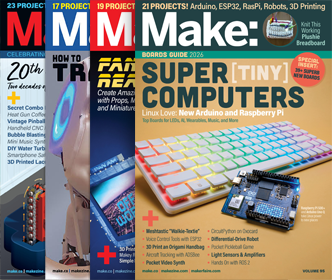Build-it-yourself cell phones
 Here’s more about the DIY cell phone project – ” Surj Patel is building his own cell phone, bit by soldered bit. It’s not easy. It starts with parts that cost around $400. Then Patel and his partner, Deva Seetharam, have to write code to run on the tiny Linux-based computer that he’s hoping will serve as the brains of his new phone. So why bother? After all, it’s not like cell phones are hard to find or terribly expensive.” [via] Link.
Here’s more about the DIY cell phone project – ” Surj Patel is building his own cell phone, bit by soldered bit. It’s not easy. It starts with parts that cost around $400. Then Patel and his partner, Deva Seetharam, have to write code to run on the tiny Linux-based computer that he’s hoping will serve as the brains of his new phone. So why bother? After all, it’s not like cell phones are hard to find or terribly expensive.” [via] Link.




 Brian sent this along, something to consider if you’re working on small form factor devices…It’s good for the environment, good for your batteries, but it’s weird to think about an algorithm’s energy efficiency (it’s not just CPU cycles they look at, but memory access as well) “PowerEscape has added a new utility to its development toolsuite. “Insight” aims to reduce power consumption by improving the “data efficiency” of C-language code. The company says improving data efficiency in the initial stages of development yields higher performance for the same amount of power.”
Brian sent this along, something to consider if you’re working on small form factor devices…It’s good for the environment, good for your batteries, but it’s weird to think about an algorithm’s energy efficiency (it’s not just CPU cycles they look at, but memory access as well) “PowerEscape has added a new utility to its development toolsuite. “Insight” aims to reduce power consumption by improving the “data efficiency” of C-language code. The company says improving data efficiency in the initial stages of development yields higher performance for the same amount of power.” 


 Formerly iPodder, here’s the latest version and information for this great open source podcatcher – “Juice has evolved from its basic beginnings as the world’s first podcasting software to a mature, fully featured application. Donation-supported Juice has been downloaded over 1 million times since its debut last year, making it the world’s most popular podcast receiver.”
Formerly iPodder, here’s the latest version and information for this great open source podcatcher – “Juice has evolved from its basic beginnings as the world’s first podcasting software to a mature, fully featured application. Donation-supported Juice has been downloaded over 1 million times since its debut last year, making it the world’s most popular podcast receiver.” 
 Paul writes “If there’s one word to describe my latest article, it’s comprehensive. Focused on using RSS as a means to save time in one’s daily routine, I take the reader through what RSS is, why it should be used and how to use it. I go through the installation, configuration and usage of RSS in Thunderbird, Google Desktop, RSSOwl as well as web-based feed readers with Google’s Personalized homepage, My Yahoo!, and Bloglines. As with all of my articles, there’s screenshots-a-plenty.” Good one to send to the non-RSSers, or if you’ve always wondered what those XML and RSS buttons are on MAKE.
Paul writes “If there’s one word to describe my latest article, it’s comprehensive. Focused on using RSS as a means to save time in one’s daily routine, I take the reader through what RSS is, why it should be used and how to use it. I go through the installation, configuration and usage of RSS in Thunderbird, Google Desktop, RSSOwl as well as web-based feed readers with Google’s Personalized homepage, My Yahoo!, and Bloglines. As with all of my articles, there’s screenshots-a-plenty.” Good one to send to the non-RSSers, or if you’ve always wondered what those XML and RSS buttons are on MAKE. 


